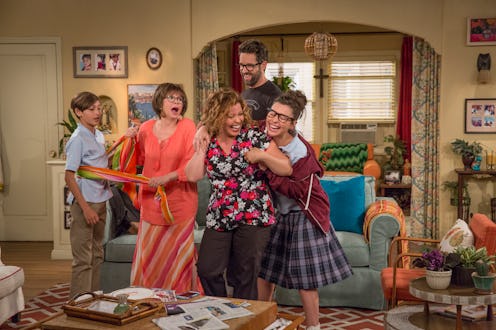
There may be a surplus of remakes in Hollywood these days, but there's one coming up that I’m actually excited about — Netflix’s One Day At A Time reboot. The 1970/80s sitcom of the same name starred Bonnie Franklin as a divorced mother who moves into an apartment building with her two daughters (who were played by Mackenzie Phillips and Valerie Bertinelli) in Indianapolis. The family becomes friends with Schneider, the superintendent of the building, and of course, hilarity ensued. While the basic premise and comedy are still present, Netflix's One Day At A Time revival is different from the original in a few ways, according to the women behind it.
For starters, this multi-camera revival features three generations living under one roof instead of just two, and it centers on a Cuban-American family. Justina Machado plays Penelope, a recently divorced military mother with a teen daughter, a tween son, and her mother (played by the legendary Rita Moreno). Oh, and Schneider is there, too, because you can’t have One Day At A Time without Schneider. But that may be where the similarities end. One of the biggest differences between the original and the reboot, executive producer and writer Gloria Calderon Kellett tells Bustle, is the issues people are dealing with now versus in the 1970s and 1980s.
"There are universal things, obviously, but there are things that are specific to living in America today," Kellett says. "Access to the internet and pop culture and how that influences and affects somebody who is really straddling two cultures." Those modern elements still connect to the true heart of the story. "It's a very American story — people coming to this country to try to make a better life for themselves and doing it for their kids and then those kids' kids," she says.
Machado also sees these elements as something that can appeal to a wide audience. “There's the character of Lydia and then the character Penelope is born here. Then my kids are born and it's just telling a universal story and putting different faces to the story so that people can relate,” she says.
Placing a Latino family at the center of One Day at a Time is also something that Kellett believes better suits the reboot to the present. “This is the perfect time to tell this story because of what's happening in this country,” she says. “I think that the representation of Latinos — we've been marginalized in a way, and I think it's a great time to tell a story about a family going through the things that American families go through, and they just happen to be Latino.”
Television should give bigger platforms to voices that aren't frequently hears, and this One Day At A Time reboot is certainly doing its part to create an authentic and accurate portrayal of life in a Latino family. “Half of our staff is Latin. Half of our staff is female. That is unheard of," Kellett says. "We also had a lot of behind the scenes people that were Latino... We had one white, male director. Everyone else was diverse or female.”
The new One Day At A Time seems primed for a post-millennial audience. It tackles the issues of today in a caring, thoughtful way, as the original did, but its cast and crew are reflective of our current world instead of the Hollywood status quo. One thing Netflix always does well is give a showrunner the reins and let them run with it, and I can’t wait to see how One Day At A Time does at the races.
Additional reporting by Samantha Rullo